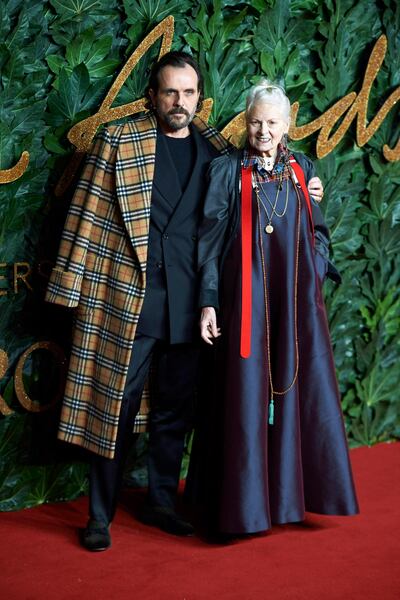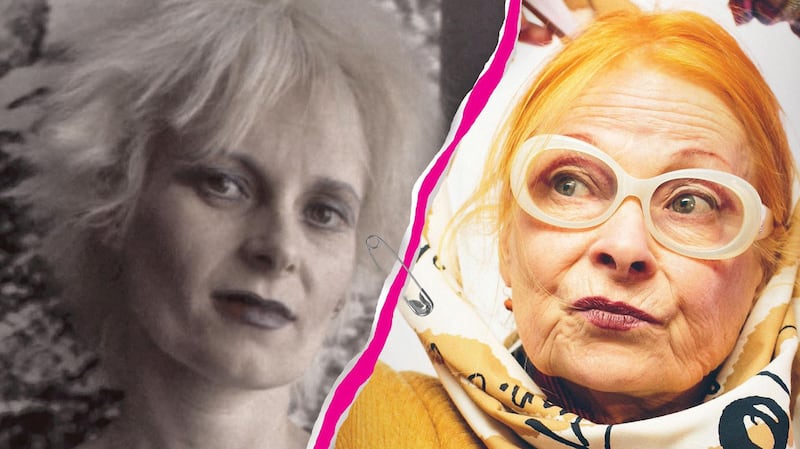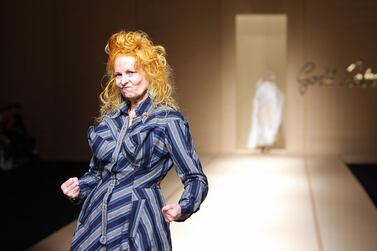British director Lorna Tucker lets us know from the start of Westwood: Punk, Icon, Activist just how much of a challenge she faced making a film about the British fashion legend.
Yes, she may have been granted permission to shadow Vivienne Westwood over a number of years, but in the first scene of her contested movie about the renowned designer, Westwood admonishes Tucker, saying to the camera that she doesn’t really want to, or even like talking about her past.
Tucker's film is a constant battle to get the British dame to open up about former lover Malcolm McLaren, former manager of the Sex Pistols and co-owner with Westwood on their London boutique Let it Rock.
The inspiration behind it
The shop later took on different monikers. Anecdotes on Johnny Rotten – the Sex Pistols’ lead singer and a frequent customer of hers and McLaren’s infamous boutique – and her own explosion into the public consciousness while dressing famous punk group the Pistols, are also less than forthcoming. “She is the most reluctant protagonist I’ve ever worked with, or will probably ever work with,” says Tucker. “I really wanted to get that across in the movie – that irreverence whereby she really doesn’t care if a film is made about her.”
But Tucker has her own, more personal, reason for wanting to make a movie about Westwood. It came after a tumultuous period in her own life. The director and former model ran away from home at 15 and ended up living on the streets, where she became addicted to drugs. One day, when she was begging outside Charing Cross Tube Station in London, she was scouted by a modelling agency.
But instead of taking up a job, Tucker tried to take her own life and ended up in rehab. Upon release, she went into modelling. It was during this period of relative stability that she first met Westwood. "She is quite an inspiring person and a stubborn person, and that automatically made me want to make a film on her," says Tucker.
Westwood was reluctant, but wanted an instrument to speak about climate change. "Her only drive to make the film at that point in her life was as a vehicle to get her message across about the environment," Tucker says.
Breaking down the film
The film is divided into three parts, juxtaposing three periods of Westwood's life: as a "punk", "icon" and "activist". The punk narrative deals with the early life of the designer, born Vivienne Isabel Swire, in Cheshire, the daughter of a storekeeper in an aircraft factory. She became a teacher and created her own jewellery, which she sold from a stall on London's Portobello Road.
In 1962, aged 21, she married a vacuum-cleaner factory apprentice, Derek Westwood, whose name she kept even after they divorced, following her dalliance with McClaren. Together, McClaren and Westwood helped define the look of the punk movement from their famous King's Road boutique.
As her relationship with McClaren came to an end, Westwood left the punk scene behind. In the film, Westwood says she came to the conclusion that: "We were not attacking the establishment, we were part of the distraction."
The "icon" section of the movie begins with Westwood at her lowest point, a figure of mockery for the media, which doesn't take her seriously, seeing her as frivolous and out of touch. She turns this view on its head to become the doyenne of the fashion world.

In her later years, the 77-year-old fashion designer turned her attention to shining a light on climate change. She's commonly seen at charity events or participating in marches.
"The film took four years to make, but we weren't filming every day," says Tucker, who surveyed many of Westwood's relatives and past business partners for the film. She interviewed Westwood's second husband and collaborator, Andreas Kronthaler, gathered anecdotes from Joseph Corre, her son with McClaren, and got a rundown of her work from long-term business partner Carlo D'Amario.
“It took some time to get the trust of not just Westwood and her partner Andreas, but also that of her team.”
'The film is the ultimate portrait'
There's a reason the film doesn't centre around the clothes. Tucker says: "I didn't want to make a fashion film – I wanted to get that sense of family and what drives them. The way you can do that is by being around so much, they forget you are even there, and that is when the magic happens."

Unfortunately, Westwood didn't share Tucker's sentiment. After the film premiered at the Sundance Film Festival last year, Westwood came out railing against the biopic, taking to Twitter to say that Tucker did not focus on her work as an activist as she had promised to. A statement from Westwood ended by saying, "It's a shame because the film is mediocre, and Vivienne and Andreas are not."
Unfortunately for Westwood, the critics and public didn’t agree, and Tucker’s documentary film has come to be appreciated as an invaluable insight into the fashion designer.
For Tucker, Westwood's decision to have no more to do with her is bittersweet. "When I got back from Sundance I thought I would be asked to sit down and have a cup of tea and do something civilised," says Tucker. "But I was told by the brand that unless I made the changes she wanted, she won't have anything to do with me or the film. It sucked because I thought we had a friendship, but it doesn't suck because I think she's being stupid as the film is the ultimate portrait.
“If I wanted to make an exposé I would have made a completely different film and that is not the film that I wanted to make. Knowing her and having witnessed her, this film is 100 per cent honest and authentic,” she adds. “I made the film because she inspired me and I thought her story could inspire people who want to be artists; who can’t afford to go to art school or fashion school and they don’t know where to go. And if you stick to what you believe in and you are good at what you do, then there’s always a place out there.”
Moving onto new projects
But Tucker has already moved on. She has just started festival screenings of her new documentary, Ama, a harrowing tale of how native American women have been sterilised against their will by the United States government.
"This is a story that needs to be told and it was a very different process to Westwood. I didn't know anything about the culture, I'm really ignorant in an innocent way and I needed to be guided."

Ama revolves around the powerful testimony of 67-year-old Navajo-Indian Jean Whitehorse about how she was sterilised against her will. In this movie, Tucker was happy to let her subjects take the lead and call the shots to highlight this appalling abuse of power.
“What I wanted to do, was say how can I serve you, then I can try and get this taken to the world so that we can talk about this.”
And talking about the issues that matter is what Tucker is best at, no matter if Westwood would swear different.
Westwood: Punk, Icon, Activist is showing at Cinema Akil, Alserkal Avenue, Dubai, from February 8 until 15
We hated our biopics, too
‘Lily Tomlin’ 1986
One of filmmaker Nick Broomfield’s earliest documentaries, a chronicle of American comedienne Lily Tomlin’s one-woman stage show, The Search for Signs of Intelligent Life in the Universe, was not in for an easy ride once Tomlin got wind of it. She said the film served as a spoiler for her show, and filed a lawsuit seeking $7 million (Dh25.7m) in damages. She largely came out victorious, with the documentary shown on television, but not widely released.
‘Tabloid’ 2010
Joyce McKinney took such issue with Errol Morris making a film about the reporting of the abduction of a young Mormon missionary by former Miss Wyoming McKinney in 1977, she would turn up unannounced at screenings and argue with the director. Her big problem seemed to be that anyone but her would make a movie on this.
‘Beats, Rhymes & Life: The Travels of A Tribe Called Quest’ 2011
Even before he had seen the film about his band, Q-Tip was tweeting: “I am not in support of the Tribe Called Quest documentary,” despite being interviewed for it. There was an argument over what credit the band would get after an email cc’d to everyone by accident declared that the band would not get a producer credit and would be treated badly by the other producers. Director Michael Rapaport eventually acquiesced to Q-Tip’s demands.
‘Soaked in Bleach’ 2015
Courtney Love sent cease-and-desist letters to cinemas showing this documentary insinuating that she was to blame for the death of Nirvana lead singer Kurt Cobain, rather than it being a suicide.
‘My Scientology Movie’ 2015
Given the exposé nature of Louis Theroux’s documentary, it’s perhaps no surprise that Mark Rathbun, a former Scientology-enforcerturned-apostate, would object to the movie in which he is seen talking extensively about his involvement with the Church of Scientology. He would claim that Theroux and the BBC used “intellectually and morally bankrupt tactics” to secure interviews and would bait the church to get a reaction.
‘Matangi / Maya / M.I.A.’ 2016
To finish his film about the Sri Lankan hip-hop artist M.I.A., director Steve Loveridge locked his friend and collaborator out of the edit. The first time the superstar saw the film was at the Sundance premiere and she was aghast: “He took all my cool out.” She complained about the lack of music in the film and its artistry. “It’s not the film I would have made,” she said. Yet, she continued to promote it.







